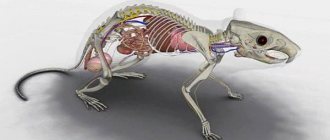Main diseases and their causes
Hamsters are susceptible not only to specific diseases that are characteristic of this particular type of rodent, for example, inflammation of the cheek pouch, but can also be infected with viruses, bacteria, and parasites. It is worth noting that most diseases of Syrian and Djungarian hamsters most often occur due to the fault of the owners. Thus, drafts can provoke colds, and an unbalanced diet leads to the development of hypo- and vitamin deficiencies, and can cause disruptions in the gastrointestinal tract and endocrine pathologies. Deficiency of vitamins, minerals, amino acids, and poor-quality feed weaken the animals’ immune potential and resistance.
Predisposing factors that can cause diseases in hamsters include:
- poor-quality diet with poor nutritional ratios;
- poor living conditions (cramped, dirty cage);
- unsuitable indoor microclimate;
- frequent stress, fear, emotional stress;
- improper care of pets.
Hamsters are susceptible to injury and often suffer from metabolic disorders and digestive processes in the body. Dzungarians and Syrians suffer from viral, bacterial, parasitic diseases, as well as non-communicable diseases. Tumors, neoplasms, and allergic manifestations (dermatitis, dermatoses) are often detected in hamsters.
Hypovitaminosis
Important! An improperly equipped cage can lead to injury to a small pet, causing dislocations, sprains, and torn ligaments. When two or more hamsters are kept in one cage, the rodents will fight for territory in real hamster fights. Moreover, such battles can often cause the death of babies or weaker individuals.
Common diseases of Djungarian and Syrian hamsters:
- obesity, diabetes;
- inflammation of the cheek pouch;
- abscesses on the paws;
- mechanical injuries (dislocations, fractures, sprains);
- ophthalmological diseases (keratitis, conjunctivitis);
- respiratory diseases of various etiopathogenesis;
- viral-bacteriological, invasive diseases;
- dermatophytosis;
- dermatitis, dermatoses, mycoses;
- colibacillosis;
- helminthic infestations;
- tularemia;
- false rabies (Aujeszky's disease);
- lymphocytic choriomeningitis;
- dental diseases.
Note that some viral, bacterial infections, parasitic diseases of dwarf hamsters and Syrian hamsters are dangerous for people. A person can become infected with rabies, salmonellosis, tularemia, dermatomycosis, campylobacteriosis, and plague from a rodent.
Inflammation of the cheek pouches in a hamster
If you purchase hamsters in pet stores, from trusted breeders, create optimal living conditions for the pet, and do not neglect the rules of hygiene, many of the diseases that hamsters suffer from can be avoided.
Risk factors
Hamster breed
Any rodent can experience severe diarrhea, but some breeds are not susceptible to ileitis. For example, dwarf hamsters.
Among patients with “wet tail”, Syrian rodents with long hair are often found. When choosing a hamster breed, study its characteristics, including propensity and ileitis. It would be a good idea to consult with the breeder and veterinarian.
Extra attention
Desulfovibrio is a bacterium that often affects young hamsters under 8 weeks of age. Weak immunity is not able to resist the pathogen. It is worth paying attention to the health of a small animal before buying it from a nursery.
Handling is dangerous
Severe stress can trigger the appearance of a “wet tail.” This often affects young rodents that are taken from their mother before the age of two months. Strengthening the immune system of a young hamster occurs within a week in a new family.
Important! When buying a small animal, do not rush to handle it often. The hamster will need time to adapt.
Gastrointestinal diseases
Ileitis in hamsters occurs as a result of E. coli entering the body. Common reasons:
- poor quality food;
- non-compliance with terms and conditions of its storage;
- irregular replacement of water in the drinking bowl;
- wet and untreated litter.
Such conditions provide a favorable environment for the development of bacteria.
Wet tail is a consequence, not a cause
At best, severe diarrhea may be due to a less serious illness. However, ileitis is difficult to treat even under the supervision of a veterinarian.
The first symptoms should be a signal to contact a veterinary hospital. It will take a lot of time and effort to save a pet.
Symptoms of diseases
How can you tell if your hamster is sick? This question interests many breeders of small pets. A healthy hamster has beautiful shiny fur, leads an active lifestyle, especially at night, and shows interest in the world around it. The animal eats food with appetite, makes supplies, and arranges its home. The Djungarian, the Syrian, has clear, clean eyes and an expressive gaze.
Important! You can understand that a rodent is sick not only by external signs, but also by the changed behavior of the hamster.
Main symptoms of diseases:
- decreased activity, lethargy, apathy;
- deterioration of fur condition (wet fur);
- severe itching;
- the appearance of scratches, bald patches, wounds, ulcers on the body;
- discharge from the nose, eyes;
- increased thirst;
- allergies, skin rash;
- bowel dysfunction (diarrhea, constipation);
- frequent urination;
- pallor, cyanosis of mucous membranes;
- sticky eyelids;
- the presence of blood and clots in the urine;
- disturbance of breathing, heart rhythm;
- accumulation of wax and dirt in the ears;
- yellowness, peeling of the skin;
- loss of cheek pouches;
- impaired coordination of movements;
- boils on the body.
In case of injuries or sprains, the hamster limps, sits constantly in the house or hides in the corner of the cage. The rodent loses a lot of weight or, on the contrary, gains weight and gains weight too quickly.
Ringworm in a hamster
Advice! Take a good look at your pet's home. If a hamster suffers from indigestion, cystitis, or endocrine pathologies, an unpleasant specific odor appears, the feces will be liquid, and the space will be filled with excrement.
If the hamster has lost weight, refuses its favorite treats, has watery eyes, swollen eyelids, the pet has become inactive, shows aggression, is breathing frequently, or other symptoms uncharacteristic of a healthy animal are noticeable, you should not ignore the problem.
If your dwarf or Syrian hamster is sick, do not self-medicate. If you discover that the rodent is sick, take it to the veterinary clinic or call a veterinarian at home. The choice of treatment methods depends on the root cause that provoked the soreness.
Features of care
At the first suspicion of infection, a sick hamster must be separated from other individuals. They should also be temporarily moved to a separate cage, and the previous one should be disinfected. Any chlorine-containing solution is suitable for this purpose.
After treatment, the rodents' house should be thoroughly rinsed with clean water. All installed equipment – toys, feeders, drinking bowls – also require disinfection.
The cage of a sick individual should always be dry and warm. The temperature in the room is 21-26°C without drafts. Carry out daily cleaning with changing bedding.
All hygiene measures must be carried out with gloves, since bacteria can pass through the owner’s hands to healthy animals. During the period of treatment and recovery, vegetables and fruits should be excluded from the hamster’s diet. It is better to offer your pet grain food - wheat, oats, rye.
Bacterial and viral diseases of the hamster
Hamsters are very susceptible to diseases caused by pathogenic microorganisms, viruses, and bacteria. Infection is possible by contact, aerogenous, nutritional means, or by eating low-quality feed. Some diseases of bacterial etiology can be transmitted to hamsters from humans and other pets.
Colibacillosis
The infection is caused by Escherichia coli, which parasitizes the gastrointestinal tract of animals. This disease of dzhungarik is also known as “wet tail”, as the sore is manifested by severe diarrhea.
Other symptoms of colibacillosis include:
- decreased, lack of appetite;
- weight loss;
- restless behavior;
- depression, lethargy, apathy;
- drowsiness;
- the presence of wet fur near the anus.
Colibacillosis
Hamster feces with diarrhea have a watery consistency. The hamster constantly curls up into a ball, hides in secluded places in the cage, and looks untidy.
The disease is characterized by an aggressive course and spreads very quickly, therefore, when keeping several animals together in a cage, you must immediately move the sick pet to another home. The disease can be cured only in the early stages of development.
Diplococcosis
An infection of the respiratory tract caused by round microscopic bacteria called diplococci. The main symptoms are lethargy, apathy, decreased activity, discharge from the nose and eyes. If the infection is severe, the dzhungarik refuses food and treats.
The disease requires immediate treatment using special serums. If therapy is not started, the pet’s death occurs on the second or third day.
Salmonellosis
The disease is caused by pathogenic rod-shaped microorganisms - salmonella. With this infection, hamsters experience foamy diarrhea, weakness, apathy, and pale mucous membranes. A sick hamster refuses food, hides in a dark corner, sits motionless, showing no interest in the world around it. The rodent's tummy is enlarged. In the stool you may notice bloody clots, threads, particles of undigested food, and mucus.
Salmonellosis in a hamster
Viral pneumonia
The disease develops against the background of weakened resistance and weakened immune potential. Prolonged hypothermia, chronic otitis, hypo-, avitaminosis can also cause the development of viral pneumonia in animals.
The disease is manifested by abundant mucous, mucopurulent discharge from the eyes, nose, refusal to feed, coughing attacks, and shortness of breath. The hamster has a wet muzzle, hoarse, rapid breathing, and pale mucous membranes. If he shakes his head, his ear, wax has accumulated in the ears, there are crusts and an unpleasant odor emanates, most likely the animal is sick with otitis media, the cause of which is a respiratory illness.
Pneumonia develops against the background of ophthalmological diseases or can provoke eye and ear diseases. With timely treatment, the hamster recovers completely within a week.
Aujeszky's disease
Pseudorabies is a deadly viral disease. The disease manifests itself as severe nervous disorders. The hamster becomes restless and may show aggression. Attacks of excitement are replaced by complete apathy. A sick pet has poor coordination of movements. Muscle spasms and cramps are noted. Death occurs due to paralysis and severe exhaustion. Treatment is carried out with special serums.
Lymphocytic choriomeningitis
One of the viral infections that poses a danger to humans. May be latent (asymptomatic). The main signs are sudden weight loss, decreased activity, refusal to feed, frequent bowel movements, and urination. Most often, the virus is transmitted from a hamster to newborn hamsters. In pregnant females, the disease provokes spontaneous miscarriages.
The infection is incurable, so if your pet is infected, it will unfortunately have to be euthanized.
Oral and dental diseases
Hamsters, like any rodents, grow their incisors throughout their lives, so owners should pay special attention to oral hygiene and the animals' teeth. If the pet does not grind down its teeth, this will lead to injury, damage to the oral mucosa, the development of acute inflammation, the formation of abscesses, and abscesses.
Pathologies and dental diseases in Djungarians and Syrians are manifested by redness of the mucous membranes, hypersalivation, decreased appetite, weight loss, abnormal growth, deformation of the incisors, and inflammation of the cheek pouches.
Inflammation of the cheek pouches is one of the most commonly diagnosed pathologies. It is characterized by inflammation, prolapse (prolapse), and the appearance of pathological formations. The disease develops due to injury to the oral mucosa. With this pathology, the animals behave restlessly, rubbing their cheeks and muzzle with their paws. Appetite decreases. Saliva flows from the mouth. As a rule, the pathological process affects the inner surface of the cheeks.
Long incisors provoke dental diseases in hamsters
To relieve inflammation, you need to rinse your pet’s mouth with an antiseptic solution or chamomile decoction. To normalize digestion, give your hamster probiotics and enzymes.
For neoplasms, surgical treatment, restorative, and symptomatic medications are prescribed.
If your hamster has inflamed cheek pouches, treatment should be carried out by a veterinarian. The specialist will carefully turn out the cheeks and clean them of food debris. Inflammation will be relieved by bactericidal drugs, antiseptics, and medications for local and general treatment. After therapy, the hamster must be kept on a fasting diet for 12–14 hours.
How can you tell if your pet is sick?
If your pet is sick, he may experience the following changes:
- apathy and lethargy;
- no appetite;
- the wool has become tangled, has lost its shine, is falling out or matted;
- there is discharge from the eyes and nose;
- pollution near the anus;
- constipation and gastrointestinal disorders;
- severe nervousness and aggression of the animal;
- temperature.
Since hamsters have a very fast metabolism, the first symptoms and signs of illness are immediately visible. At the same time, the deterioration of the condition also occurs quickly, which is why it is very important to provide the pet with the necessary help and treatment in a timely manner.
Parasitic, fungal, dermatological diseases and symptoms
Hamsters, regardless of breed, often suffer from parasitic and fungal diseases. Djungarians are diagnosed with lichen, dermatophytosis, and trichomoniasis. The main manifestations of mycoses are severe itching, restlessness, deterioration of the coat, the appearance of rashes on the body, scratching, wounds, and long-term non-healing ulcers. With dermatophytosis, the skin acquires a yellowish tint and is very flaky. If treatment is not started, pathogenic flora penetrates into wounds and scratches, which provokes inflammation in various structures of the dermis.
Wet eczema in a hamster
Important! If a hamster is sick with a parasitic or fungal disease and is kept in the same cage with other rodents, immediately isolate the sick animal and disinfect the pet’s home.
Hamsters are susceptible to dermatitis, dermatoses of various etiologies, as well as allergies. Deterioration in the condition of the coat, partial or complete baldness is provoked by frequent stress, deficiency of vitamins, minerals, external parasites, fungi, and substances of a toxic nature.
Your veterinarian will tell you how to treat mycoses. The pet will be prescribed fungicidal, antibacterial agents, solutions (Miramistin, Chlorhexidine), as well as antiparasitic shampoos.
Diagnostics
To make a diagnosis, the veterinarian will base the diagnosis on a combination of all the signs of a wet tail. A clear clinical picture makes it possible to prescribe treatment.
If the breeder has a large number of individuals, then you can try to make an accurate diagnosis using laboratory tests. This is necessary not only to save one pet, but also to take measures to protect other individuals.
For diagnostic purposes, secretions - feces, saliva - are collected from the infected animal. The resulting material is placed in a nutrient medium and, after the bacteria multiply, it is studied under a microscope.
Thus, Campylobacter can be detected, whereas Lawsonia intracellularis, due to its inability to live outside the cells of the host organism, cannot be detected.
To collect statistical data, the veterinarian may conduct tests for the presence of antibodies to gram-negative bacteria at the onset of the disease and after recovery. For the same purpose, the body of a hamster after death is studied through an autopsy.
The activity of bacteria leads to thickening and inflammation of the small intestine and enlargement of the lymph nodes of the abdominal cavity. In the intestines there is a viscous yellow liquid interspersed with blood.
Treatment
The regimen is prescribed by a veterinarian after determining the clinical manifestations. Most often used:
Antibiotics. Baytril – 0.5% solution for injection. The active ingredient is enrofloxacin. In the instructions for the drug, the dosage is 0.4 ml per 1 kg of weight.
It is impossible to calculate it for a hamster yourself. The course of treatment is 7-14 days.
Probiotics. Emprobio, Bifitrilak, Lactoferon. The preparations contain beneficial bacteria and their metabolic products. They are necessary to restore the balance of intestinal microflora and stimulate the production of antibodies.
The dose for an individual weighing 45-50 g is 0.1 ml. Probiotics should be given to the animal in diluted form - food, pure liquid.
Solutions for correcting water balance disorders. A dehydrated individual requires hydration therapy. It is carried out by a veterinarian, giving intra-abdominal and subcutaneous injections with Ringer's lactate, saline and glucose.
To generally strengthen and maintain body functions, the hamster is added to the diet with ascorbic acid and Catozal, which accelerates metabolic processes at the cellular level.
Neoplasms, tumors
Tumors (malignant, benign), pathological growths on the body, legs. ears is a fairly commonly diagnosed pathology in rodents, which can develop for a variety of reasons. Bumps can appear due to injuries, severe bruises, or falls from a height. To begin treatment, you need to establish a diagnosis, so take your pet to a veterinarian.
For benign and malignant tumors, surgical treatment will be prescribed. If the cancer is localized in a hard-to-reach area (oral cavity), or the tumor has metastasized, veterinarians recommend euthanizing the hamster, since no treatment method will give the desired result.
Eye diseases and their treatment
Small animals often suffer from ophthalmological diseases. Allergic, serous, purulent conjunctivitis, cataracts, glaucoma, and uveitis are noted in hamsters. In these diseases, blepharospasm, lacrimation, swelling, swelling, and sticking of the eyelids are observed.
Treatment should begin immediately as soon as you notice the first symptoms. Do not forget that eye diseases can provoke not only a deterioration in visual function, but also cause complete or partial blindness.
Conjunctivitis
In medical therapy, the choice of methods depends on the stage, nature of the disease, and the root cause. Solutions for washing the eyes and ophthalmic drops may be prescribed.
Endocrine pathologies, gastrointestinal diseases
Endocrine disorders, metabolic failures, hormonal imbalances, and disruptions in the digestive tract in most cases are provoked by improper feeding of a small pet. Metabolic disorders can also be hereditary.
Among the most common endocrine pathologies in hamsters are:
- diabetes;
- obesity;
- vascular diseases;
- stone disease;
- polycystic ovary syndrome (in females).
Hormonal imbalances in females most often cause frequent childbirth and an unbalanced diet. Hamsters become lethargic or, on the contrary, irritable. The pet's tummy is swollen and the frequency of bowel movements is disrupted. Treatment is surgical.
Gastrointestinal diseases (poisoning, enteritis, food allergies) develop due to a violation of the feeding regime, if the hamster has a poor-quality, meager diet or due to exposure to various toxins on the body. The diseases are accompanied by unstable stools, rumbling in the stomach, decreased appetite, and lethargy. A veterinarian will tell you how to cure a hamster and what to do if the digestive processes are disrupted, having established an accurate diagnosis and cause.
Obesity in a hamster
Prevention:
- two-week quarantine for each new individual purchased;
- buying a hamster not at a poultry market, but at a nursery, from a breeder with an impeccable reputation;
- balanced diet and stress prevention;
- hygiene: regular washing of the cage and accessories;
- disinfection.
If your previous hamster had wet tail disease, you need to thoroughly disinfect all equipment before getting a new pet. The cage is washed with soap and water and treated with a product containing bleach. You can scald it with boiling water. After treatment, the cage is ventilated for 2 months.
Other diseases of hamsters
Hamsters are susceptible to cardiovascular pathologies, which can be congenital or acquired. Among Syrians and Djungarians, problems are detected in the functioning of the excretory system (cystitis, pyelonephritis), nervous disorders (encephalitis), which develop against the background of severe stress, due to overheating. It is worth noting that severe fright can provoke paralysis and cause cardiac arrest, which will lead to the death of the hamster.
In any case, if you notice that your pet’s behavior has changed, your pet has become lethargic and inactive, do not ignore the problem. Many hamster diseases can be cured in the early stages of development. Therefore, be sure to show your pet to a doctor or call a veterinarian at home. However, remember that many diseases and pathologies that occur in hamsters are easier to prevent thanks to proper care and maintenance.
We invite you to join our Zen channel and group on VKontakte or Odnoklassniki, where new articles for pet owners are published.
Similar articles:
- The simplest things that can harm a guinea pig
- Djungarian hamster at home: advice for the future owner
- How to organize leisure time for a guinea pig?











